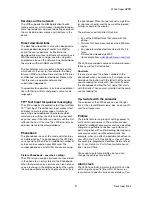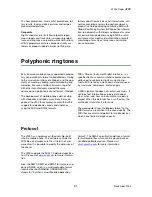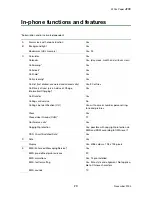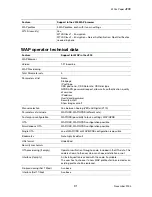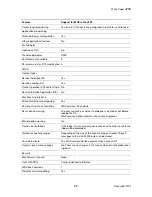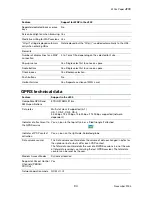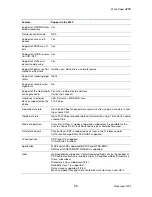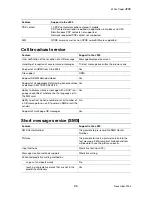
White Paper
J200
21
November 2004
TV show promotions, music artist promotions, lot-
tery results, food and drink pictures and recipes,
mood-related pictures.
Corporate
Flight schedules, pre-installed corporate logos,
map snippets and travel info, company branded
icons and ring tones, corporate e-mail notifications,
affinity programmes where companies notify cus-
tomers of product updates, banks notifying cus-
tomers about new services and interest rates, call
centres providing answers to questions about a
product, vehicle positioning combining EMS with
Global Positioning System (GPS) position informa-
tion, job dispatch with delivery addresses for sales
or courier package delivery, using EMS in a retail
environment for credit card authorization, remote
monitoring of machines for service and mainte-
nance purposes.
Polyphonic ringtones
Early Ericsson mobile phones supported a proprie-
tary non-polyphonic format called eMelody. Owing
to the musical limitations of eMelody, and the pop-
ularity of creating, sending, and downloading ring
melodies, Ericsson and Sony Ericsson, together
with other manufacturers created the more
advanced non-polyphonic sound format – iMelody.
The development of mobile phones did not stop
with iMelodies, and today, many Sony Ericsson
phones (the J200 for example), come with built-in
support for polyphonic sounds and ringtones,
using the MIDI and SMAF formats.
MIDI – Musical Instrument Digital Interface – is a
specification for a communications protocol princi-
pally used to control electronic musical instru-
ments. MIDI is today a well known standard used
by musicians, composers, and arrangers.
A MIDI signal or file does not contain any music. It
contains text information as binary data about
what, when, and how an instrument or melody is
played. When this data reaches a synthesizer, the
synthesizer translates it into music.
The development from the iMelody format to the
MIDI format is a revolution in the sound quality. The
MIDI files are small, and perfect for mobile devices,
which have limited storage capacity.
Protocol
The J200 has a hardware synthesizer chip, built
into the mobile phone. The software controls the
MIDI files, and makes sure they fit into the hard-
ware chip. It is possible to modify the dynamics of
the sound.
The J200 supports the MIDI 1.0 detailed specifica-
tion. Please visit
www.midi.com
for more informa-
tion.
Also, the SMF0, SMF1 and SMAF formats are sup-
ported. SMAF, which is a multimedia data format
invented by the YAMAHA® CORPORATION,
stands for "Synthetic music Mobile Application
Format". The SMAF specification defines a format
for multimedia files which can be played back on
handheld portable devices. Please visit
smaf-yamaha.com
for more information.



